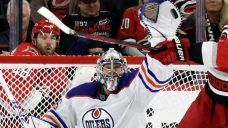EDMONTON — Through his first 12 starts, Stuart Skinner was ‘The Problem.’
Then his team stabilized in front of him. And behind a more consistent, readable attack, his game settled down, and the team began to win.
Today, over his last four starts (since Nov. 23), Skinner’s .931 save percentage ranks second in the entire National Hockey League, while his 1.72 goals-against average is third among goalies with four starts.
He outduelled Vezina winner Connor Hellebuyck last week in Winnipeg, as suddenly his team had the best goalie on the ice on a given night, a rare occurrence in Edmonton this season.
Small sample size, you say?
We’d tend to agree.
But what about stats posted behind a defensively derelict Oilers team that gave up more goals off the rush than any team in the league during the opening six weeks of the season? Was Skinner’s game the root, or the result, of a 2-9-1 start?
How much of Skinner’s overall stats picture — an .881 and a 3.16 — is due to the mess his team was in front of him?
“Well, a puck goes in the net and you’re immediately looking at the goalie,” began defenceman Brett Kulak. “Then you look at the D, and then the forwards come in — but it's never their fault (laughs). Goalies have the most weight on them, that’s for sure.”
Every year, more stats are invented to tell us which kinds of shots, and from where, are eluding a goalie. They are instructive, but the eye test can be the most damning.
Every Canadian hockey fan figures they know a bad goal when they see one, and the rule of thumb is the same no matter which team you cheer for:
When your team scores, it’s almost always a great shot and a fine play. When the other team scores, either the goalie should have had it or all the credit goes to a defensive mistake.
At most stats sites, a slot shot is a slot shot — whether it’s Auston Matthews firing the puck, or Ryan Reaves. A deflection goal impacts your save percentage and goals against no more or less than a goal from centre ice.
“Expected saves and all that stuff,” began Skinner, “the camera can see a lot of it. But it's different when you're the guy doing it. When you're actually down there doing the work, there are things that happen on the ice.
“So yeah, stats are great. But I try not to be too concerned about (them).”
I recall Darryl Sutter, when he was coaching the Los Angeles Kings to two Stanley Cups, stating that he needed “a .925 save percentage” from his No. 1 goalie in order to win. That number has plummeted in the days since the Kings were kings.
Prior to Monday night’s games the NHL leader in wins among goalies was Alex Georgiev with 13. His save percentage was .900.
So, what should a save percentage look like for a successful starter today?
“That's not really for me to (answer), to be honest,” said Skinner. “You (media) guys can tell me what’s a good save percentage, and what’s a bad one.
“That's not my concern, if I'm gonna be completely blunt.”
There is no argument between the eye test and the fancy stats: Skinner’s game deteriorated over his 12 playoff starts last spring. He was a rookie, sure, but an .883 save percentage just won’t cut it. You can’t argue that.
But as skill and speed begin to take over the game we should also lower our expectations as to what constitutes acceptable netminding numbers. Look at some stats from around the league, again, prior to Monday’s games:
• Among 29 goalies with at least a dozen starts, only 13 are better than .910. Just 18 are .900 or better.
• Juuse Saros and Georgiev (.900) lead a pack of relatively high pedigree goalies who are at .900 or less:
Joonas Korpisalo (.897)
Jacob Markstrom (.896)
Darcy Kuemper and Frederik Andersen (.894)
Ville Husso (.891)
Marc-Andre Fleury (.884)
Ilya Samsonov (.878)
Andrei Vasilevskiy (.859)
“When it comes to stats,” Skinner said, “I think everyone's more concerned with the win column. I mean, that's how you get into playoffs right?
“If you have a .960 and you lose 1-0 every single game, you're not going to make the playoffs and then you're not going to be able to be a champion. (Winning) is our biggest concern.”
It becomes hockey’s biggest chicken-and-egg scenario: Have the Oilers turned it around because the goalie is playing better? Or is the goalie playing better because the team has turned it around?
Either way, good goaltending is good for the health of a hockey team.
“It just goes into the whole mojo of the team,” Kulak explained. “If something is not happening — we’re not scoring — it doesn't feel good. If we're letting goals in, it doesn't feel good. Goalies are shaky? Doesn't feel good.
“You need to have a solid group, and if everyone's playing (good) you're going to be stronger for sure.”
With a six-game homestand beginning Wednesday against Carolina, some stability in the net couldn’t come at a better time for the Edmonton Oilers.








COMMENTS
When submitting content, please abide by our submission guidelines, and avoid posting profanity, personal attacks or harassment. Should you violate our submissions guidelines, we reserve the right to remove your comments and block your account. Sportsnet reserves the right to close a story’s comment section at any time.